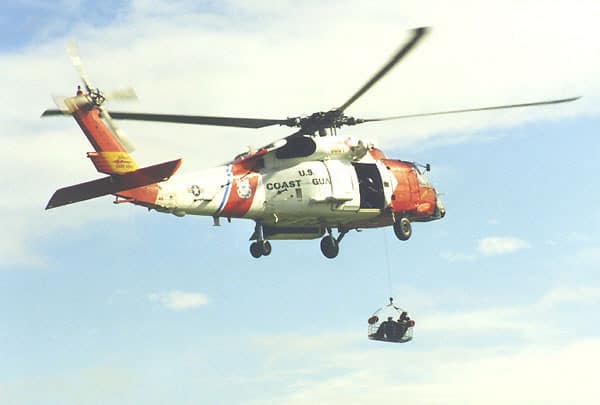
Air Station Cape Cod crews fly both MH-60T “Jayhawk” helicopters and HC-144 “Ocean Sentry” fixed wing turboprops to perform a variety of Coast Guard missions. The primary mission, Search and Rescue (SAR), involves the protection of life and property in the offshore areas from the Canadian border to Long Island, New York.
During the 1960s the Coast Guard employed the helicopter with a great deal of success as a rescue platform. With the development of the HH-52A, an amphibious helicopter, the need for a flying boat was lessened. Therefore, air stations having only water landing capabilities were being phased out. Air Station Salem, the predecessor to Air Station Cape Cod, was such an air station.
The Service began to search for a replacement facility, one that could grow with the anticipated new aircraft needed in the future. In 1968 an agreement was reached with the DOD to utilize the Otis Air Force Base on Cape Cod as the new home of a Coast Guard Air Station. Coast Guard Air Station Cape Cod was established on August 29, 1970 and the Coast Guard Air Station at Salem, MA and the Coast Guard Air Detachment at Quonset Point, RI were decommissioned. This provided a much greater degree of efficiency in the maintenance and operations of the Sikorsky HH-52A ” Sea Guard”, the Sikorsky HH-3F “Pelican” and the Grumman HU-16E “ Albatross”. These versatile amphibians served at the air station until they were replaced by longer-ranged aircraft in the early 1980’s.
The medium range rescue Sikorsky HH-3F helicopter worked side-by-side with its counterpart the HH-52A, a short range rescue helicopter, until 1984 when the HH-3F assumed the duties of both aircraft. The HH-3F enabled the air station to reach farther off shore and its greater payload allowed it to carry more equipment and survivors. The HH-3F continued to protect the northeastern area until replaced by the Sikorsky HH-60J Jayhawk, a new medium range rescue helicopter, in 1991. The HU-16E Albatross was replaced when the Coast Guard entered the jet age. On March 10, 1983 the last HU-16E in the Coast Guard inventory, HU-16E CGNR 7250 was officially retired at Air Station Cape Cod. It is proudly displayed at the air station. Its replacement, the HU-25A Guardian, a turbofan jet manufactured by the Falcon Jet Corporation, could fly 600 miles at 400 knots, orbit for 30 minutes, drop survival equipment while pinpointing the position of a distressed vessel. The Guardian proved itself vital in drug interdiction as well as SAR with state-of-the-art radar and sensory packages on board. Cape Cod also had HU-25 aircraft equipped with Aireye, an airborne oil spill tracking and mapping system. The Aireye side-looking-airborne-radar (SLAR) excels not only at monitoring oil pollution but also has been used to track icebergs in support of the International Ice Patrol. The last Cape Cod HU-25, number 2133, is displayed alongside the HU-16E at the entrance to the Air Station. The Guardian was replaced by the HC-144 “Ocean Sentry”, a twin engine turboprop built in Spain by Airbus Military. The transition to the HC-144 was completed in 2011.
The primary mission of the United States Coast Guard since its beginning has always been the protection and safety of life and property at sea. In the past two decades, air crews from Air Station Cape Cod have launched on over 6700 cases, saved nearly 2400 lives, and prevented the loss of $340 million worth of property.
Probably the air station’s most famous rescue occurred as recent as 1987. In March of that year, the Soviet Motor Vessel Komsomolets Kirgizzii sank 200 nautical miles south of the Massachusetts coast. Three of Air Station Cape Cod’s helicopters rescued the 37-man crew from the Russian ship in 20 foot seas and winds gusting to 50 knots with no major injuries. For their extraordinary efforts, the air crews were invited to the White House by President Reagan to be honored in a Rose Garden ceremony. The event marked the first time a Coast Guard aircrew has been so honored.
With the transfer of the Coast Guard to the Homeland Security Department the Air Station has added Airborne Use of Force and Vertical Insertion to its rotary wing capability. Aircrew are designated as Aviation Gunners and trained to fire weapons from the aircraft if needed in a Law Enforcement/Homeland Security mission. Vertical insertion enables a crew to begin pre-planned law enforcement missions by rapidly deploying a boarding team to a vessel using “Fast Rope” techniques.
As DOD tenants of Otis Air Base realigned over the past 30 plus years, Coast Guard presence on the Base continued to grow. In addition to the air station, Coast Guard Base Cape Cod was established in order to consolidate the non-aviation CG activities, including the Coast Guard Northeastern Regional Fisheries Training Center, Electronic Support Detachment Cape Cod, Marine Safety Detachment Cape Cod, Atlantic Area armory, and Port Security Unit 301. As a result of the Base Closure and Realignment Act the 102nd fighter group of the Massachusetts Air National Guard was re-designated as an Intelligence Wing and the Coast Guard assumed full responsibility for all aspects of maintenance, approach lighting, tower operations, weather forecasting, NAVAIDS and snow removal in 2008.
Air Station Cape Cod celebrated its 50th anniversary in 2020. The history of Air Station Cape Cod can be traced back through Air Station Salem, MA (1935-1970) and Ten Pound Island, in Gloucester Harbor (1925-1935).

